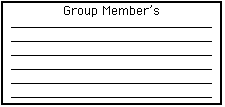You are a secret agent from a competing amusement park. You task
is to take a roller coaster and find out EVERYTHING you can
about the roller coaster.
NEATNESS COUNTS!


PART 1 Most roller coasters wrap themselves in a circle. Draw a
SCALE drawing of your roller coaster's first 5 peaks and dips if you
could straighten it out. (You do not have to use the all the
horizontal length of this graphing space -the numbers are just for
reference.)


 Label each hill's peak as a letter,
A - E on your scale drawing. You do not have to use every letter.
Note , the top of a loop counts as a hill peak.
Label each hill's peak as a letter,
A - E on your scale drawing. You do not have to use every letter.
Note , the top of a loop counts as a hill peak.
Label each dip as a number, 1 - 5 on your scale drawing. You do not
have to use every number. Note, each time the roller caster is at the
bottom of the loop counts as a different dip.
PART 2 Calculate the height at each peak.
PEAKS
A  B
B  C
C
 D
D  E
E

PART 3 Calculate the velocity at each letter and number.
PEAKS
A  B
B  C
C
 D
D  E
E

DIPS
1  2
2  3
3
 4
4  5
5
 6
6 
PART 4 Someone in your group needs to ride the roller coaster.
Measure the g's at the first 4 dips and hill. Note which part of the
car your are riding in at the time of the measurement.
g's Number of rows of seats from the font (middle is best)
1 

2 

3 

4 

PART 5 Measure the g's at the first 2 dips and the first 2
peaks after the initial hill from the back, middle and front of the
train.
For each location indicate how many seats from the front your are
riding.
Location BACK g's MIDDLE g's FRONT g's
A 


B 


1 


2 


PART 6 Using the velocity and acceleration for each dip,
calculate the radius of curvature for the first 4 dips.
1  2
2 
3  4
4 
PART 7 What is the average velocity for the entire ride? 
PART 8 Excluding the time it takes for the roller coaster to
travel up the first hill, Estimate the length of the remaining track,
measure the time it take for the train to travel this length and
calculate the average velocity for this section of track.
Length: 
Time: 
Average Velocity: 
PART 9 Esti-measure the height of the first DROP. 
PART 10 Use your estimated numbers and any other numbers you
need to measure and/or calculate to calculate the height of the first
drop using conservation of energy methods.
Height from energy relationships: 
If you use or find this page useful or have any
comments, please contact the author so maybe he'll do more.
Author: Tony Wayne
"ROLLER COASTER PHYSICS" TABLE
OF CONTENTS ... PHYSICS PAVILION TABLE OF
CONTENTS
<--PREVIOUS
SECTION ... NEXT SECTION
-->